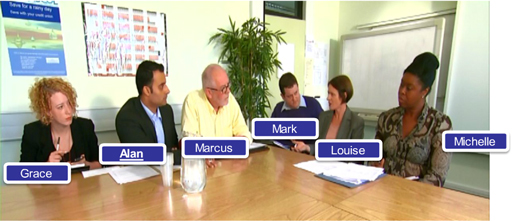Facilitating group discussions
Use 'Print preview' to check the number of pages and printer settings.
Print functionality varies between browsers.
Printable page generated Wednesday, 8 May 2024, 8:56 PM
Facilitating group discussions
Introduction
Welcome to this free course on facilitating group discussions.
You’ll start by looking at what is meant by ‘facilitation’ and at different styles of facilitating.
You will have the chance to assess your preferred facilitation style, and also to identify skills that you need to develop to become more effective in this role.
Then you’ll be asked to watch a series of video clips showing facilitation in action.
You’ll meet Alan as he tries to facilitate a meeting of an established group – a chaotic meeting.
Next you will listen to a dialogue between Alan and a more experienced facilitator, Lisa, to see how she handled similar situations in the past.
Lastly, you will see Alan facilitating another meeting of the group – more successfully this time!
To get the most from this course, please enrol. This way the answers you give on-screen will be kept when you come back later. Alternatively, you should note your answers in a notebook.
This OpenLearn course is an adapted extract from the Open University course Q91 Business Management.
Learning outcomes
After studying this course, you should be able to:
understand the key skills and behaviours required to facilitate a group discussion
prepare effectively before facilitating a meeting
consider some of the difficult behaviours that can occur in meetings
think of some possible strategies for dealing with these.
1 What is facilitation?

Before considering the skills of facilitating group processes, it is important that you have a good understanding of what facilitation means. So let’s start by defining what is meant by ‘facilitation’.
Activity 1
Part One
Write down your understanding of what facilitation means. Then read the discussion.
Part Two
Discussion
Collins English Dictionary states the meaning of facilitation as:
- ‘To assist the progress of…’
- ‘To make easier…’
A facilitator is someone who assists the progress of individuals or groups, making processes easier. A facilitator helps individuals and groups to achieve their goals – that is, the goals set by the individuals or groups, not by the facilitator.
The facilitator can help:
- in the process of team formation
- groups to clarify their goals
- by assisting the progress of groups as they work together
- groups to resolve conflict and dissent
- in the group’s review of its performance.
What you want to gain from this course
Before you start, you may find it helpful to think about what you wish to gain from studying this course and how you can use facilitation within your role.
Activity 2
Write your thoughts in this box.
So now you have a definition and a general overview of facilitation. But what does a facilitator actually do? What is their role and responsibility?
2 The facilitator’s role
The facilitator’s role is to assist the group’s efforts towards its objectives.
The facilitator:
- is a neutral servant of the group – ‘neutral’ means that the facilitator is an impartial observer; ‘servant of the group’ means that the facilitator is working to the group’s agenda, not their own.
- does not contribute or evaluate ideas – the facilitator’s contribution concerns group processes and only very rarely the content of the meeting.
- focuses the energy of the group on its task – the facilitator’s role is to ensure that the group is working well together to achieve its objectives.
- suggests alternative methods of working – the facilitator helps the group by offering alternative ways of solving the problem or of looking at the situation.
- protects individuals and their ideas from attack – the facilitator acts as a referee in times of conflict, disagreement or tension in the group.
- encourages everyone to participate – the facilitator ensures that all group members feel able and willing to make a contribution.
- helps the group to find ‘win-win’ solutions – the facilitator ensures that outcomes are beneficial to all parties.
- coordinates pre- and post-meeting logistics – the facilitator may be involved in the logistics of the meeting arrangements and in the follow-up.
Activity 3
Thinking about the list above, write down what the facilitator does not do. Then compare your list with ours.
Discussion
Your list could have said that the facilitator does not:
- contribute to the content of the meeting
- decide that one person’s ideas are better than another’s
- let sub-grouping affect the performance of the team
- let the group go off track
- allow individuals to come under attack
- let certain individuals dominate the discussion at the expense of others in the group
- allow the group to find a solution that is only agreeable to the minority.
3 Facilitation styles

Facilitating has a number of different styles. Let’s explore what they are and how, why and when to use different styles in different contexts.
Part of a facilitator’s role is to adapt to the needs of the group. Sometimes the facilitator will be expected to direct the group’s discussions or activities; sometimes they will cooperate with the group, and at other times the facilitator may have to make suggestions to the group.
Groups vary in their ‘maturity’ – i.e. in the way they behave, not just the length of time they have been working together.
The styles of facilitation required in each of the three situations can be simplified as shown in Table 1.
| Facilitator style | Group’s maturity |
|---|---|
DIRECT Facilitator directs methods used within the group | IMMATURE Newly formed or one-off group |
COOPERATE Facilitator works with the group to decide choice of methods and when to provide assistance | SEMI-MATURE Group formed for some time but still not performing to full potential |
SUGGEST Facilitator respects autonomy of group and gives them freedom to find their own way | MATURE GROUP Self directing and generally working effectively together |
To test your understanding of the different facilitation styles, complete the following activity
Activity 4
Part One
Look at the stage of group maturity and decide which style of facilitation would be most appropriate. Type your responses in the boxes before looking at the answers.
1. You have been asked by another department to facilitate a focus group. The participants will be customers of the department, many of whom have not met previously. The discussions are to last for one hour.
Answer
Direct
Part Two
2. You work as a facilitator for a group of customer services staff. Much of the team’s work is self-directed and the team work well together.
Answer
Suggest
Part Three
3. You have been asked to attend a management meeting as a facilitator. The group of managers know each other well and have been working together for some time. However, their director feels there is conflict in the group and has asked you to facilitate this meeting.
Answer
Cooperate
3.1 Understanding your current style
Part of a facilitator’s skill is to adapt their natural style to meet the needs of the group. Recognising your own natural style will help you become more aware of where you need to adapt and how.
Those who have a directing style will tend to want to tell the group what to do. This style can be closely associated with training, as a trainer will tend to structure the group and what it does.
Cooperation involves a partnership between the facilitator and the group, where decisions on how the group operates are made on an equal basis.
A suggesting style leaves the group to decide how they work together. The facilitator makes inputs to the group only at the group’s suggestion.
Activity 5
Complete the questionnaire below as a quick guide to your preferred style of facilitating. For each statement, choose one reply that typifies your behaviour. Keep a note of your choices as you will score them when you finish.
Part One
- Someone comes to you with a problem they have with the behaviour of another member of the group.
Are you most likely to:
- a.Listen to their problem and then suggest to them what they should do?
- b.Spend time with the person to discover the reason for the problem, and then work with them to help them work out a solution?
- c.Ask the person what help they need from you?
Part Two
- You are facilitating a group, the meeting has been running for some time and you notice that people are looking tired.
Are you most likely to say:
- a.‘Everyone’s looking tired. Let’s stop here for a ten minute break.’
- b.‘How are people feeling right now?’
- c.‘I get the impression that everyone’s feeling tired right now. What do the group want to do about it?’
Part Three
- A group you are facilitating is trying to reach agreement on an important issue. Two of the six members have a different point of view from the rest.
Are you most likely to say:
- a.‘The group seems unable to agree unanimously on a solution – what do you think we should do?’
- b.‘We have a majority agreement on this issue, let’s go with that.’
- c.‘The group seems totally undecided. What would you like me to do to help you reach a decision?’
Part Four
- You have been asked to facilitate a group while their usual facilitator is on holiday.
Are you most likely to:
- a.Ask the group what they expect of you before the meeting begins?
- b.At the beginning of the meeting, explain how you prefer to facilitate and the role of the facilitator?
- c.Let the group get on with their meeting and only input when requested?
Discussion
How to score
Look at Table 2 and for each question note whether your choice was allocated a C, a D or an S. Then count up the number of Cs, Ds and Ss you have scored.
| Question 1 | Question 2 | Question 3 | Question 4 |
|---|---|---|---|
|
|
|
|
- If you scored 2 or more Ds
You have a tendency to ‘Direct’. This style can be appropriate for less mature groups. However, it may cause you problems when dealing with semi-mature and mature groups as it does not encourage ownership.
- If you scored 2 or more Ss
Your tendency is to ‘Suggest’. This style encourages groups to come up with their own solutions to problems and is best used with mature groups.
- If you scored 2 or more Cs
You tendency is to ‘Cooperate’. You have the ability to be flexible according to the needs of the group. You will work particularly well with semi-mature groups.
Whatever your natural tendency, remember: to be a successful facilitator you need to adapt your style to the needs of the group.
The next section offers some tips on how to do this.
3.2 Adapting your style to the needs of the group
As mentioned, the facilitator’s style should be related to the stage of maturity of the group. The more mature the group, the less direction it will need from the facilitator.
In every group there are three dimensions that the facilitator needs to be aware of:
- Content – the content of the meeting or task in hand. This includes the content of what is said; opinions and views as well as what the group is working on.
- Method – how the group is organising itself to achieve the task: the techniques used to give structure to events, e.g. group discussion, work in pairs, brainstorming and so on.
- Process – what’s happening while the group is working together: the unspoken and often unnoticed aspects of group behaviour such as overall climate and atmosphere, hidden agendas, inclusion and exclusion, often indicated by non-verbal behaviour.
Imagine that content, method and process are a boat:
- Content is the crew taking control of the task in hand.
- Methods are the sails that allow the ship to move towards its destination.
- Process is the hold of the ship: most of it is beneath the waterline but unless the loading is even, the ship will founder.
Understanding group processes is probably one of the hardest and most skilled tasks of the facilitator.
4 Facilitative behaviours
What skills do you need for effective facilitation? The next activity will help you to analyse your own skills as a facilitator.
Activity 6
Part One
In order to increase your competency in the skills of facilitation, you may find it useful to undertake a brief analysis of those skill areas in which you feel confident, and the skills which you feel you need to improve. You may also wish to share this questionnaire with someone you work with in a group, and then compare your own scores with those of the other person.
Below is a list of statements: read each statement and, thinking about your typical behaviour in a group, make a note of the number which best agrees with your assessment of your skills, where:
1 = disagree strongly
2 = disagree slightly
3 = neither agree nor disagree
4 = agree slightly
5 = agree strongly
| 1 | I find it easy to get on with most people. | 1 | 2 | 3 | 4 | 5 |
| 2 | When I meet new people I have no problem in developing a relationship. | 1 | 2 | 3 | 4 | 5 |
| 3 | Even when I have strong opinions, I am able to hold my tongue. | 1 | 2 | 3 | 4 | 5 |
| 4 | I do not show my feelings even when I hear something I dislike. | 1 | 2 | 3 | 4 | 5 |
| 5 | I find it easy to let people have their say. | 1 | 2 | 3 | 4 | 5 |
| 6 | I am a listener rather than a talker. | 1 | 2 | 3 | 4 | 5 |
| 7 | I make good use of questions to establish facts. | 1 | 2 | 3 | 4 | 5 |
| 8 | I am not afraid to probe for underlying feelings and concerns when I feel it is appropriate. | 1 | 2 | 3 | 4 | 5 |
| 9 | I find it easy to observe detail. | 1 | 2 | 3 | 4 | 5 |
| 10 | I can interpret body language effectively. | 1 | 2 | 3 | 4 | 5 |
| 11 | I can quickly summarise the content of a conversation. | 1 | 2 | 3 | 4 | 5 |
| 12 | I find it easy to get to the heart of an issue. | 1 | 2 | 3 | 4 | 5 |
| 13 | I am not afraid of conflict. | 1 | 2 | 3 | 4 | 5 |
| 14 | I have confidence to deal with difficult situations. | 1 | 2 | 3 | 4 | 5 |
You may prefer to print out this activity and circle the numbers.
Discussion
Scoring
Now look at your scores. Add the following two questions together and note your scores.
Questions 1 and 2, which relate to empathy, score out of 10.
Questions 3 and 4, which relate to neutrality, score out of 10.
Questions 5 and 6, which relate to listening, score out of 10.
Questions 7 and 8, which relate to questioning, score out of 10.
Questions 9 and 10, which relate to observation, score out of 10.
Questions 11 and 12, which relate to summarising, score out of 10.
Questions 13 and 14, which relate to intervention, score out of 10.
How to interpret your scores
The average score for this questionnaire is 7 for each section. A score lower than this indicates that you need to increase your competence in this area. Above this score and you should already have the skills to help you become an effective facilitator – but practice always makes perfect!
Part Two
Finally, look at your score for each section and summarise your development needs in the box below.
5 Facilitation in practice
Let’s now take a look at facilitation in action and follow Alan as he attempts to facilitate a meeting of an established group.
Meet the participants
Before you watch the meeting, let’s see who is attending.
There is the facilitator (Alan), the chair (Marcus) and the rest of the group (Grace, Mark, Louise and Michelle).
5.1 A chaotic meeting
The following activity allows you to consider how Alan could have approached this meeting.
Activity 7
Meeting facilitation
Watch this video clip in which Alan attempts to facilitate a meeting of an established group.
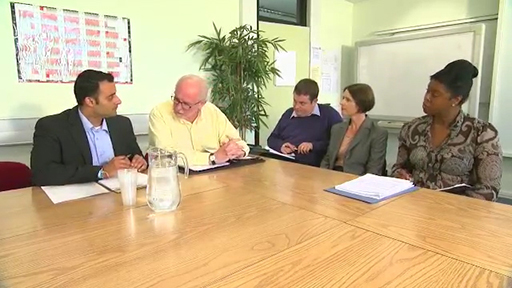
Transcript: A chaotic meeting
As you watch the video make a note of:
- what you saw going wrong
- what you think Alan could have done differently.
You will come back to your thoughts on this later.
You will gain much more by actively engaging with the content, rather than by simply observing it.
What went wrong?

So what did you notice about how the meeting went?
Look back at your notes and pick out the key difficulties Alan encountered that you think he will mention when he gets together with Lisa (a more experienced facilitator) to review the meeting.
5.2 Alan’s learning journey
Let’s find out how Alan views things and follow him as he explores with Lisa how to overcome such difficulties.
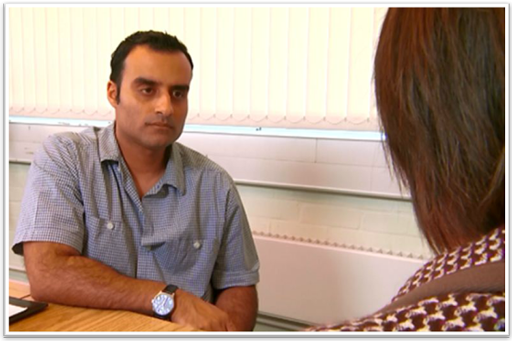
There are five pairs of video clips.
- The first of each pair shows a discussion between Alan and Lisa.
- In the second, you will see how Lisa handled a similar problem with this group in the past.
How the meeting went
You will now watch and consider two videos: ‘So how did the meeting go?’ and ‘So how is this going to work?
Activity 8
Video 1: ‘So how did the meeting go?’
Watch Alan and Lisa discuss how the first meeting went.
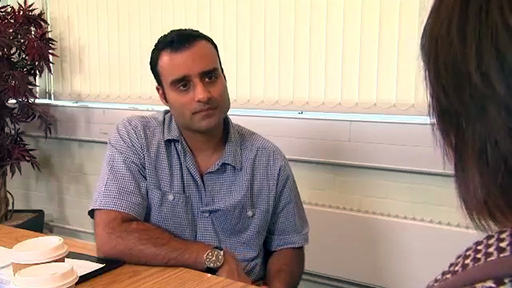
Transcript: So how did the meeting go?
Reflections on Lisa and Alan’s review of the meeting
- How many of Alan’s difficulties did you pick out?
- How well do the principles of good facilitation match the kind of facilitation you are likely to be involved with?
Note your thoughts in the box below.
Video 2: ‘So how is this going to work?’
Now see how Lisa handled things with Mark in an earlier meeting.
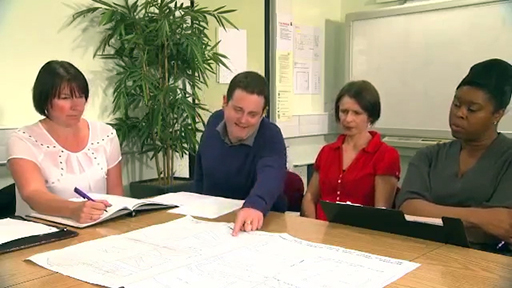
Transcript: So how is this going to work?
Reflections on Lisa with Mark
- What skills did you notice Lisa using?
- Would you have done anything differently, and if so, what?
Note your thoughts in the box below.
In the next section you will watch Lisa and Alan in their next discussion.
Moving on
Watch and consider the next two videos, ‘And we moved right on’ and ‘That’s a really good point’.
Activity 9
Video 1: ‘And we moved right on’
Watch Alan and Lisa review the interaction with Mark and discuss the difficulties of getting Louise to engage.
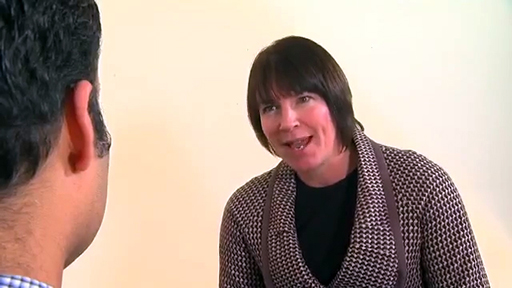
Transcript: And we moved right on
Video 2: ‘That’s a really good point’
Now watch Lisa in an earlier meeting with Louise.
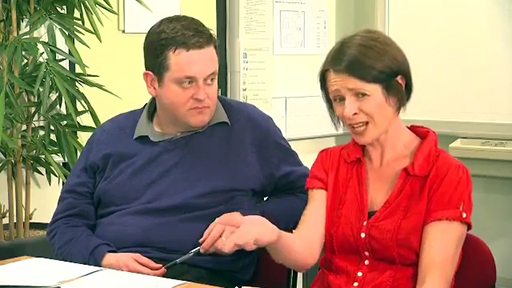
Transcript: That’s a really good point
Reflections on Lisa with Louise
- What did Lisa do to draw Louise in and get her viewpoint heard?
- What other ways could she have approached this?
Note your thoughts in the box below.
Finding options
You will now watch and consider two videos, ‘So in the end the group found options’ and ‘So the idea is’.
Activity 10
Video 1: ‘So in the end the group found options’
Watch Alan and Lisa discuss Louise, and how to engage Grace.
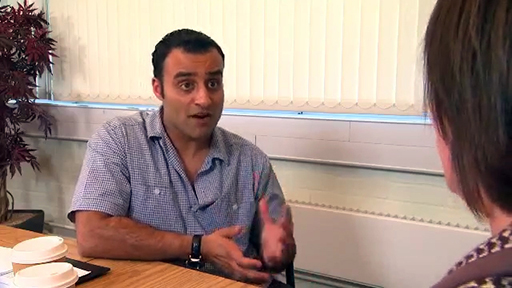
Transcript: So in the end the group found options
Video 2: ‘So the idea is’
Observe how Lisa gets Grace to contribute to the discussion.
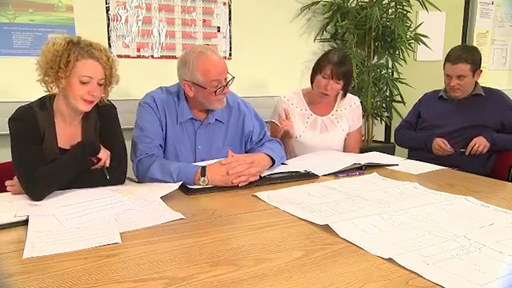
Transcript: So the idea is
Reflections on Lisa with Grace
- What did you notice about what Lisa did?
- In what other ways could she have got Grace to engage in the discussion?
Note your thoughts in the box below.
Keeping the group focused
You will now watch and consider two videos, ‘That seems a bit harsh’ and ‘That just about sums up’.
Activity 11
Video 1: ‘That seems a bit harsh’
Watch Alan talking with Lisa about Grace and then how to handle Marcus.
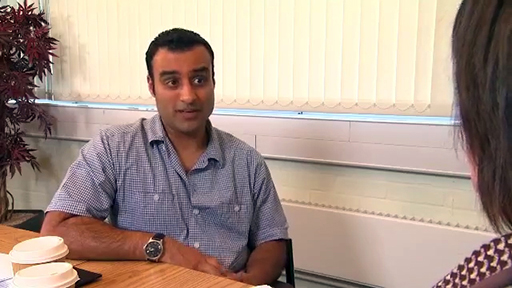
Transcript: That seems a bit harsh
Video 2: ‘That just about sums up’
Observe how Lisa works with Marcus.
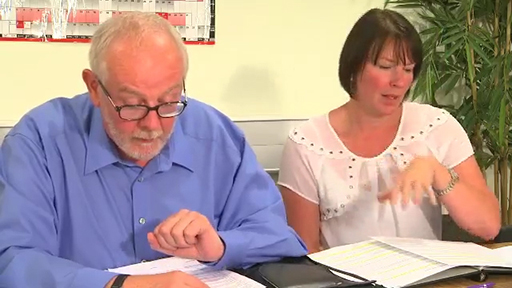
Transcript: That just about sums up
Reflections on Lisa with Marcus
- What approach did Lisa take with Marcus?
- What other ways could she have handled the situation?
Note your thoughts in the box below.
Keeping on track
You will now watch and consider two videos, ‘It did take a few reminders’ and ‘Well, I can’t agree to this’.
Activity 12
Video 1: ‘It did take a few reminders’
Lisa and Alan review the interaction with Marcus and discuss Michelle.
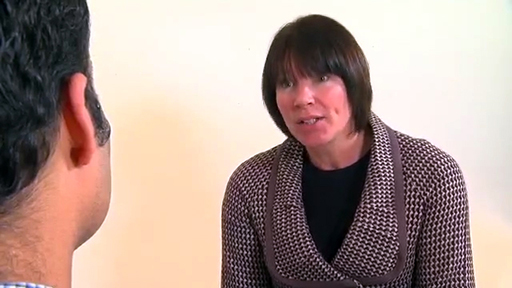
Transcript: It did take a few reminders
Video 2: Well, I can’t agree to this
See how Lisa copes with Michelle’s frustrations.
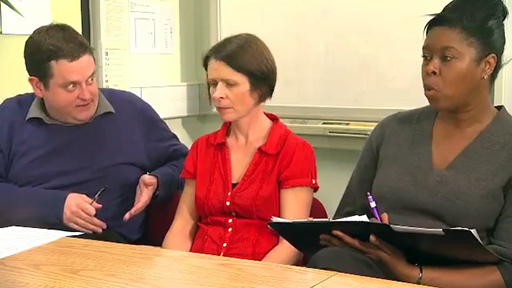
Transcript: Well, I can’t agree to this
Reflections on Lisa with Michelle
- What was Lisa’s approach to dealing with Michelle?
- What else could she have done?
Note your thoughts in the box below.
Not an easy outcome
Watch and consider the video, ‘So it wasn’t an easy outcome’.
Activity 13
Video 1:
Lisa and Alan review Michelle’s response and Alan prepares for the next meeting of the group.

Transcript: So it wasn’t an easy outcome
Reflections on the video examples
Before you watch Alan have another go at facilitating a meeting of this group, write down the preparations you would make before attending such a meeting.
- How would you start?
- What outcomes would you be looking for?
- What would you be watching out for, and what strategies would you use if problems occurred?
Note your thoughts in the box below.
5.3 A better meeting
In this final video, ‘A better meeting’, you will see how Alan facilitates his next meeting with the group.
Activity 14
Video 1:
Watch how Alan begins his next facilitation with the group.

Transcript: A better meeting
Reflections on the better meeting
- What did Alan do differently this time?
Write down all that you noticed him doing.
Notes
- How did this differ from how you would have started the meeting?
Note your thoughts in the box below.
6 Resources to help with difficult situations
In this section you will find strategies to help you prepare for difficult situations.
They cover how to approach:
- someone who isn’t participating in the discussion
- an over-talkative and/or dominating individual
- people having side conversations instead of paying attention to the meeting
- an individual who is unable or unwilling to take responsibility for actions
- someone who constantly complains about the way things are done
- a group that agrees with everything.
6.1 Under-participation
Some participants are very quiet and aren’t participating in the discussion.
The challange
- While some people speak up, others sit in silence.
- When asked if they have anything to say, they decline.
- Sometimes an entire group will sit back and say nothing.
What’s really going on
- Some people are unaccustomed to attending meetings, let alone being asked to participate in discussions.
- Some people feel insecure about the quality of their ideas.
- Others may fear that their ideas aren’t going to be heard or, worse, fear that they’ll actually get rebuked for speaking out.
- Participants may be afraid of saying something inappropriate in front of their peers or managers.
- The presence of a senior person may intimidate participants and cause them to shut down.
- Over-participants may be shutting down the quieter people.
Facilitator pitfalls
- Failing to find out if the presence of certain people might have a negative effect on participation.
- Assuming that quiet people have nothing to add.
- Sticking with a large group format for most discussions.
- Not setting ground rules that create safety and comfort at the meeting.
- Leading a discussion in which only the high participants have a voice.
- Forgetting to invite quiet people into the conversation.
Intervention strategies
- Put people at ease at the start of the session by assuring them that no one will be asked to do anything that puts them on the spot.
- Design your meeting around techniques that create safety and get everyone involved (e.g. get people to talk in pairs before talking in a bigger group; use small group discussions; invite people to write their ideas on Post-it notes or flipcharts distributed around the room).
- Encourage the group to create ground rules that encourage open participation by asking: ‘How can we make sure that everyone participates and no one dominates?’ or ‘What conditions or assurances would encourage people to speak freely?’
- Maintain eye contact with the under-participants so they know they’re not forgotten and are always welcome to add their views.
- Call on quiet people by name, especially if their body language indicates that they may have something to say.
- Find non-threatening roles for quiet people, such as timekeeper, to make them feel valued.
- Encourage under-participants by thanking them for contributing.
6.2 Over-talkers
An individual supplies excessive detail or is over talkative and dominating the session.
The challenge
- Individuals who can’t limit how much they talk.
- People who provide a level of detail that isn’t needed or appropriate to the situation.
- Group members who are oblivious to what others want to hear.
What’s really going on
- Some people have an inflated sense of their own importance.
- Some people simply love to hear themselves talk.
- Dysfunctional talkers are often oblivious to what others need to hear.
- Over-talking may be a ploy to get attention or to gain control.
- Some people are simply insensitive to the needs or behaviours of others.
Facilitator pitfalls
- Not checking with the rest of the group to determine what they need to hear.
- Failing to establish guidelines for presentations.
- Standing by and allowing over-talkers to continue past pre-set time limits.
- Using overly harsh or judgemental language when intervening.
- Coming across as unsure when asking over-talkers to curtail their comments.
Intervention strategies
- Help the group set clear time limits for each presentation.
- Appoint one of the group members to act as timekeeper and periodically call out milestones.
- Help the group establish guidelines for each presentation:
‘Before the presentations begin, let’s talk about the level of detail people need and some of the specific questions you want to have answered.’
- Ask the group to establish a targeted norm/ground rule at the start of any meeting where you suspect over-talking might occur:
‘We’ve got a really tight agenda today. What commitments do we each need to make to honour our time-frames?’
- Help over-talkers correct themselves by offering them specific feedback:
‘You’ve been giving us a lot of implementation details rather than offering an overview of project goals. Please refocus your presentation to be in line with the guidelines we set earlier.’
- If the over-talker shows no sign of self-control, stop him or her and check with the rest of the group:
‘I’m going to stop you and check with the rest of the group to make sure this is the right time to hear more of your report.’
- Firmly point out that the group members are violating their time limits, and clearly state what you want them to do:
‘You’re now five minutes over your allotted time. I'm concerned others won’t get a chance to present. Please wrap up.’
- If none of the above interventions has an impact, take over-talkers aside and give them feedback in a way that encourages them to take responsibility for their actions in future meetings:
‘At today’s meeting, you ran over by 20 minutes, even though I asked you to end your presentation twice. This threw the meeting seriously off schedule. I need a commitment from you to ensure that this doesn’t happen in the future.’
6.3 Side chatters
People chat with those next to them instead of paying attention to the group discussion.
The challenge
- Some of the side chats are short and respectful, but others are long and disruptive.
- When a serious or contentious item is on the table, some people turn to a colleague and tell them what they really think, rather than share their comments with the group.
- At some point, the side conversations become distracting.
What’s really going on
- Some people do this subconsciously.
- Others mistakenly believe that if they’re not actively engaged in the topic under discussion, it’s OK to conduct a side meeting.
- Side chatting can be symptomatic of a low trust environment where people are reluctant to speak openly.
Facilitator pitfalls
- Ignoring side chatting, perhaps because senior people are doing it.
- Failing to identify if side chatting is a sign of confusion, disagreement or other hidden problems.
- Allowing a group to meet without effective ground rules that define behaviours.
- Making judgemental or confrontational comments when trying to end side chatting.
Intervention strategies
- Help the group create a balanced set of ground rules or meeting guidelines that help them control side chatting.
- If a distracting side chat takes place and you feel that you need to intervene, try this approach using open, supportive language:
‘I’m concerned that we’ve lost you to the conversation and are making decisions without you. Your ideas are valuable so we need you back in the conversation.’
- If a topic suddenly causes everyone to turn to the person next to them, try a structured partner chat. Ask each person to find a partner, and set a time frame. Let them have their side chats, and then gather up as much of their discussions as they’re willing to share.
- If certain people are persistent side chatters, take them aside and offer them feedback:
‘I’ve noticed that you engaged in several lengthy side chats in today’s meeting. I found this to be very distracting. Would you please not do this in future meetings?’
6.4 Unwilling to take responsibility
Individuals say they are unwilling or unable to take responsibility for actions.
The challenge
- As soon as the group identifies action plans, people start making excuses about why they can’t take responsibility.
- The reliable workhorses volunteer while others evade responsibility.
- Members start to give tasks to people who aren’t at the meeting.
- Some group members insist that you take on the action points.
What’s really going on
- Some individuals may lack the skills necessary to take on tasks.
- Others may be feeling that they’re already overworked.
- The group may be lacking cohesion; people don’t feel any sense of responsibility for each other.
- People may be wary if actions from previous meetings weren’t supported by the organisation or didn’t yield results.
- Evading responsibility may be a deliberate ploy by people who are harbouring a personal grudge.
Facilitator pitfalls
- Allowing people to assign tasks to absent colleagues.
- Loading more work on the same few people who always volunteer.
- Not surfacing or dealing with resistance to taking responsibility.
- Allowing the group to foist tasks on you.
Intervention strategies
- Tell people from the outset that they will need to take responsibility for actions.
- Help the group create a specific ground rule about taking responsibility for implementing actions (e.g. ‘What commitments are you prepared to make today to ensure that things move forward?’ or ‘How can we ensure that tasks are divided equally and don’t all fall on a few people?’).
- Engage members in a problem-solving conversation about what’s keeping them from taking on actions.
- Create coaching relationships so that experienced people are available to provide support to less experienced team members.
- Seek outside assistance to remove blockages to taking responsibility. Encourage senior managers to act as ‘Change champions’.
- State clearly that it’s not your role to take responsibility for actions (and make sure you agree this up-front with senior management/key stakeholders/the sponsor).
- Put a ‘Bring forward’ item on future agendas to ensure that the group reviews actions from previous meetings and recognises progress.
6.5 Complainers
An individual is continually complaining about the organisation’s policies and the way things are done.
The challenge
- Individuals become ‘stuck’ on policies and procedures that they perceive as blockers to getting any constructive work done.
- People talk over each other, not hearing other’s view points and ideas.
- Some groups have developed an entrenched pattern of thinking having been at an organisation for a long time.
- People may be resistant to change the status quo.
What’s really going on
- Group members have been disillusioned when their actions have been blocked in the past by policies and procedures.
- Individuals disagree strongly with policies and procedures and want to express their opinion.
- There is a misfit between the individual and organisation type.
- Individuals are cynical about the task in hand and/or feel that they do not have the authority to make a difference – so why bother?
- People may have developed an ‘us against them’ attitude.
Facilitator pitfalls
- Ignoring the comments and forging ahead with the meeting.
- Cajoling members into being more cynical.
- Criticising the individual for being cynical.
- Allowing the individual to derail the meeting without making an intervention.
- Allowing the discussion to continue without checking with the rest of the group to see if the discussion is one that they want to pursue.
Intervention strategies
- Do your homework beforehand to see if the group do have the authority to make decisions in the session.
- Explain that policies cannot be changed in the session, and that its purpose is to help everyone to work as best they can within the system. Focus on areas the group can affect.
- If none of the above interventions has an impact, take over-talkers aside and give them feedback in a way that encourages them to take responsibility for their actions in future meetings:
'Focusing on policies that cannot be changed hinders the positive work that can be done. Do you have any ideas that can help work around the policies that we do have influence or control over?'
6.6 Agrees with everything
The group agrees with everything.
The challenge
- People go along with decisions without saying what’s on their mind.
- Decisions are made without thorough analysis and discussion.
What’s really going on
- Everyone is in agreement and a good solution has been identified.
- There is a power differential in the room and no one feels confident enough to openly disagree with a leader or manager.
- People are not interested in the topic and wish to bring the session to a conclusion as quickly as possible.
- The discussion has taken a long time, and individuals want some form of closure even if it means settling for something other than a win/win situation.
- Individuals do not have any real investment in the outcome.
Facilitator pitfalls
- Failing to find out beforehand whether there will be a power differential within the room which will be likely to dominate decisions.
- Assuming that unanimous group agreement means that there are no concerns with regard to the decision.
- Sticking to a large group format.
- Not setting ground rules to create safety and comfort to facilitate open discussions.
Intervention strategies
- Ensure agreement is genuine so that reservations aren’t revealed at a later date, possibly in more destructive ways.
- Ask some ‘devil’s advocate’ questions to test the strength of the agreement.
- Create a safe climate and stress that disagreement can be very valuable for encouraging creativity and identifying the best solution.
- Split the group into pairs or smaller groups to discuss the options – have small groups feedback on flip charts and discuss. This will provide a safer environment to allow disagreement. Other ‘safe’ alternatives that allow individual contributions to remain anonymous can also help (secret ballot, etc.).
7 Learning review and action plan
Activity 15
Part One
Look back at your notes from this short course – your facilitation style, the skills you have or would like to develop, and your reflections on the video situations. Also look back to your thoughts on what you hoped to gain from studying this course.
Reflect on what you have learned and make some notes below.
Part Two
What have you learned?
Part Three
What specifically will you do to take your learning forward?
Conclusion
This free course has introduced you to a number of different styles of facilitation. You should now feel you have a better understanding of the key skills and behaviours required to facilitate a group discussion. You should feel more comfortable about preparing before a meeting, be aware of some of the difficult behaviours that can occur in meetings and know of some possible strategies for dealing with these. We really hope you've enjoyed the course.
Acknowledgements
Except for third party materials and otherwise stated in the acknowledgements section, this content is made available under a Creative Commons Attribution-NonCommercial-ShareAlike 4.0 Licence.
The material acknowledged below is Proprietary and used under licence (not subject to Creative Commons Licence). Grateful acknowledgement is made to the following sources for permission to reproduce material in this course:
Course image: Envato in Flickr made available under Creative Commons Attribution 2.0 Licence.
Every effort has been made to contact copyright owners. If any have been inadvertently overlooked, the publishers will be pleased to make the necessary arrangements at the first opportunity.
Don't miss out:
If reading this text has inspired you to learn more, you may be interested in joining the millions of people who discover our free learning resources and qualifications by visiting The Open University - www.open.edu/ openlearn/ free-courses
Copyright © 2016 The Open University
